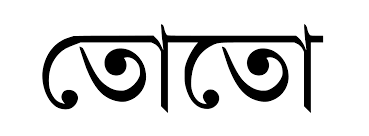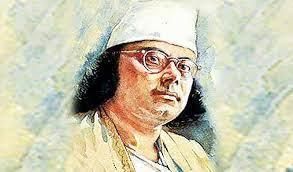History, Art & Culture - 4 | Current Affairs & Hindu Analysis: Daily, Weekly & Monthly - UPSC PDF Download
| Table of contents |

|
| Toto Language |

|
| Sant Meera Bai |

|
| Kazi Nazrul Islam |

|
| Sharda Temple |

|
| Kolkali Dance |

|
Toto Language
The Toto language, spoken by a mere 1,600 individuals in West Bengal, is facing the threat of extinction.
- However, to aid in its preservation, a trilingual dictionary (Toto-Bengali-English) titled "Toto Shabda Sangraha" is scheduled to be unveiled in Kolkata on October 7, 2023.
About the Toto Language:
- The Toto language belongs to the Sino-Tibetan language family and is spoken by the Toto tribal community in regions of West Bengal bordering Bhutan.
- Recognized as a critically endangered language by the United Nations Educational, Scientific and Cultural Organization (UNESCO), the Toto language is predominantly spoken orally. Despite efforts, including the development of a script by community member Dhaniram Toto in 2015, many still use the Bengali script or language for writing.
The Toto People
- The Toto community is an indigenous and secluded tribal group exclusively inhabiting a small region known as Totopara in Jalpaiguri, West Bengal, India.
- As per the 2001 census, the entire Toto population is less than 2000, residing solely in Totopara. Identified as Mongoloid people, the Totos predominantly practice endogamy, preferring marriage within their own tribal community.
- The Toto family structure follows a patrilocal system, where a married couple typically resides with the husband's parents, and it is predominantly of the nuclear type. However, joint families are not uncommon. Monogamy is a prevalent form of marriage among the Toto, although polygamy is not explicitly prohibited. Additionally, the Totos do not have a tradition of divorce in their culture.
Sant Meera Bai
Prime Minister Modi participates in an event marking the birth anniversary of Sant Meera Bai.
Details
- Meera Bai, also known as Meera, emerged as a notable saint, poetess, and devoted follower of Lord Krishna during the Bhakti movement in India.
Early Life and Background
- Birth and Family: Meera Bai, born around 1498 AD in Rajasthan, India, belonged to the royal family of Merta. Her profound devotion to Lord Krishna began in her early years, influenced by tales of Krishna's childhood.
- Marriage to Prince Bhoj Raj: Despite her royal status, Meera Bai married Prince Bhoj Raj, the heir of the Chittor kingdom. However, her unwavering devotion to Lord Krishna often led to conflicts within the royal household as her spiritual commitment took precedence over worldly responsibilities.
Devotion to Lord Krishna
- Bhakti Movement: Meera Bai played a significant role in the Bhakti movement, a spiritual and devotional wave emphasizing a personal connection with the divine and promoting love and devotion as paths to salvation.
- Expressing Devotion through Poetry: She channeled her profound love for Lord Krishna into soul-stirring poems, including bhajans and padavalis, which conveyed her spiritual yearning and intense desire for union with the divine.
About the Bhakti Movement
The Bhakti Movement, originating in medieval India, marked a significant socio-religious revolution that stressed devotion (bhakti) and fostered a personal, emotional connection with the divine. It emerged in response to the inflexibility of ritualistic practices, caste-based discrimination, and the hierarchical structure prevailing in society during that period.
Origins and Historical Context:
- Era of Emergence: The Bhakti Movement began approximately in the 7th to 8th centuries AD and gained prominence between the 14th and 17th centuries during the medieval period.
- Influence of Scriptures: Drawing inspiration from ancient scriptures like the Bhagavad Gita and devotional texts such as the Puranas, the movement underscored the significance of devotion, love, and surrender to the divine.
Core Principles of the Bhakti Movement:
- Personal Devotion: Bhakti emphasized devotion as a pathway to salvation, encouraging a personal, emotional bond between the devotee and the chosen deity.
- Equality and Inclusivity: The movement advocated for the equality of all individuals, irrespective of caste, creed, or social status, promoting a direct connection between the devotee and the divine without intermediaries.
- Simplicity and Universality: Propagating a simple and universal approach to spirituality, the movement transcended the complexities of rituals and elaborate religious practices.
Key Figures and Their Contributions:
- Ramanuja, Madhvacharya, and Chaitanya Mahaprabhu: These saints from diverse regions of India made significant contributions to the Bhakti Movement, each presenting unique philosophies and teachings.
- Mirabai, Kabir, Tulsidas, and Surdas: Notable poet-saints composed devotional songs and verses in regional languages, expressing profound love and devotion to their chosen deities.
Impact and Legacy:
- Social Reforms: The Bhakti Movement challenged social hierarchies and caste-based discrimination, advocating for social equality and inclusivity.
- Cultural Influence: It led to the proliferation of devotional music, literature, and art forms across various regions of India, enriching the country's cultural heritage.
- Religious Syncretism: The movement facilitated the synthesis of diverse religious beliefs and practices, fostering religious tolerance and harmony among different communities.
Conclusion
Meera Bai's life exemplified unwavering devotion and love for Lord Krishna, transcending societal norms and embracing spirituality. Her profound poetry and dedication to Krishna continue to inspire spiritual seekers and devotees worldwide, making her a revered figure in the Bhakti movement and leaving an indelible mark on Indian spiritual and literary heritage.
Kazi Nazrul Islam
A filmmaker has expressed regret for the unintended distress caused by its interpretation of the iconic song "Karar Oi Louho Kopat," written by Bengali poet Kazi Nazrul Islam in 1922.
Who was Kazi Nazrul Islam (1899-1976)?
- Kazi Nazrul Islam was born on May 24, 1899, in Churulia, a village in the Burdwan district of West Bengal, India.
- He was a renowned poet, author, and musician hailing from Bengal.
- Famous for his songs, known as "Nazrulgeeti," they enjoy widespread popularity and admiration in West Bengal and Bangladesh, much like Rabindrasangeet composed by Rabindranath Tagore.
- Often referred to as the "Vidrohi Kavi (Rebel Poet)," Nazrul penned over 4,000 songs, many of which focused on protests and resistance against unjust governance and powerful rulers.
- His compositions served as a source of inspiration for freedom fighters in Bengal during their struggle against British colonial rule.
- Kazi Nazrul Islam is honored as the national poet of Bangladesh and holds significant reverence in West Bengal, India.
Understanding “Karar Oi Louho Kopat”
- Nazrul was an ardent supporter of India’s struggle for independence from British colonial rule. He used his poetry and writings to inspire and mobilize people against British oppression.
- Published in 1922 in “Banglar Katha” and later included in Nazrul’s “Bhangar Gaan,” the song was penned as a call to break down the iron gates of prison, symbolizing resistance against British oppression.
- He wrote the song of revolution after the British threw Deshbandhu Chittaranjan Das (1870-1925) in prison in 1922.
Sharda Temple
The recent demolition of the Sharada Peeth Temple in Pakistan-Occupied Kashmir (PoK) has sent shockwaves through the international community. This heritage site, located close to the Line of Control (LoC), was partially razed to make way for a coffee house, defying a Supreme Court order to protect the temple.
- The incident sheds light on the ongoing challenges faced by minority communities in Pakistan, particularly Hindus, who endure targeted violence, killings, and encroachments on their sacred lands.
Attack on Minority Sentiments
The destruction of Sharada Peeth raises questions about international preservation efforts aimed at safeguarding cultural and religious heritage in the region. This article delves into the historical significance of Sharada Peeth, its architecture, and the myths associated with it. Moreover, it explores the implications of this act on the religious sentiments of minority communities in Pakistan.
About Sharada Peeth
Location
- Situated along the Neelum River in PoK, approximately 10 km from the LoC, Sharada Peeth rests on Mount Harmukh.
Origin of Name
- The name "Sharada Peeth" translates to "the seat of Sharada," the Kashmiri name for the goddess Saraswati. It may also derive from ancient words meaning "flow or stream" and "blow, tip, or rock," reflecting its location at the confluence of three streams.
Construction
- Historical records differ on its construction, attributing it to Emperor Asoka in 237 B.C. or during the rule of Kushans in the early 1st century. Raja Lalitaditya's role is also cited in containing the influence of Buddhism.
Historical Records
- Notable figures like Al Biruni, Kalhana, Abul Fazal, and Bilhana have documented Sharada Peeth's significance, emphasizing its revered status and influence.
Legend
- Place of Learning: Sharada Peeth was a renowned center of learning, attracting students from distant regions. Adi Shankaracharya's visit popularized the Sharada script, earning Kashmir the moniker "Sharda Desh" or "country of Sharda."
- Architecture of the Temple: Built in Kashmiri style with red sandstone, the temple's elevated platform, west-facing entrance, and Doric-style columns reflect its architectural richness.
- Myths Associated: Legends surround Sharada Peeth, including a cursed river, a magical floating rock, and curses attributed to the Pandavas and Goddess Saraswati.
Religious Significance
- Shakti Peeth: Believed to be one of the Maha Shakti Peethas, the temple represents the spiritual location of the goddess Sati's fallen right hand.
- Pilgrimage Site: Sharada Peeth holds immense importance for Kashmiri Pandits, ranking among the three holiest pilgrimage sites alongside the Martand Sun Temple and the Amarnath Temple.
Sharada Peeth Corridor Idea
- Post-Kartarpur Corridor Success: Following the success of the Kartarpur Corridor, the idea of a Sharada Peeth Corridor has been discussed between the governments of India and Pakistan.
- Problems Associated: However, certain elements within the Pakistani establishment oppose the corridor due to perceived security concerns. The issue of territorial recognition adds complexity, as PoK is not acknowledged by India, and the LoC lacks legitimacy as a border.
Conclusion
The demolition of Sharada Peeth highlights the broader challenges faced by minority communities in Pakistan and underscores the need for international efforts to preserve cultural and religious heritage in the region. The proposed Sharada Peeth Corridor, while holding potential for religious harmony, faces obstacles that require careful consideration and resolution.
Kolkali Dance
Kolkali is presented by the mothers' collective of the Thrissur Archdiocese as a tribute to the arrival of St. Thomas in India.
About
Origin
- Kolkali, a traditional folk art form, originates from the Malabar region of Kerala. It is also known as Thattinmelkali when performed on wooden stages.
Performance Style
- This dance involves participants forming a circle, striking small sticks, and maintaining rhythm through special steps. The circle dynamically expands and contracts as the dance progresses.
Cultural Significance
- Highly popular in the Kerala School Kalolsavam, considered the largest cultural event in Asia.
Styles
- Two distinct styles exist: Actual Kolkali and Thekkan Koladi. Actual Kolkali encompasses various forms like Thacholikali, Rajasooyam, etc. Unfortunately, Actual Kolkali is on the verge of extinction.
Occasions for Performance
- Kolkali is performed during celebrations of joy, to spread happiness, and notably during the paddy harvest season.
Community Participation
- Villagers, regardless of caste and creed, actively participate in Kolkali performances, showcasing its inclusive nature.
Inclusivity
- Remarkably, Kolkali is performed by troupes representing diverse communities, including Muslim, Christian, and Harijan communities.
About St. Thomas
- St. Thomas, one of the twelve apostles of Jesus Christ, is believed to have arrived in India in the 1st century AD. According to tradition, he landed in the southwestern state of Kerala. St. Thomas is credited with spreading Christianity in India, particularly in the Malabar Coast region.
|
38 videos|5288 docs|1117 tests
|
FAQs on History, Art & Culture - 4 - Current Affairs & Hindu Analysis: Daily, Weekly & Monthly - UPSC
| 1. What is the Toto language? |  |
| 2. Who was Sant Meera Bai? |  |
| 3. Who was Kazi Nazrul Islam? |  |
| 4. What is the Sharda Temple? |  |
| 5. What is Kolkali dance? |  |

























